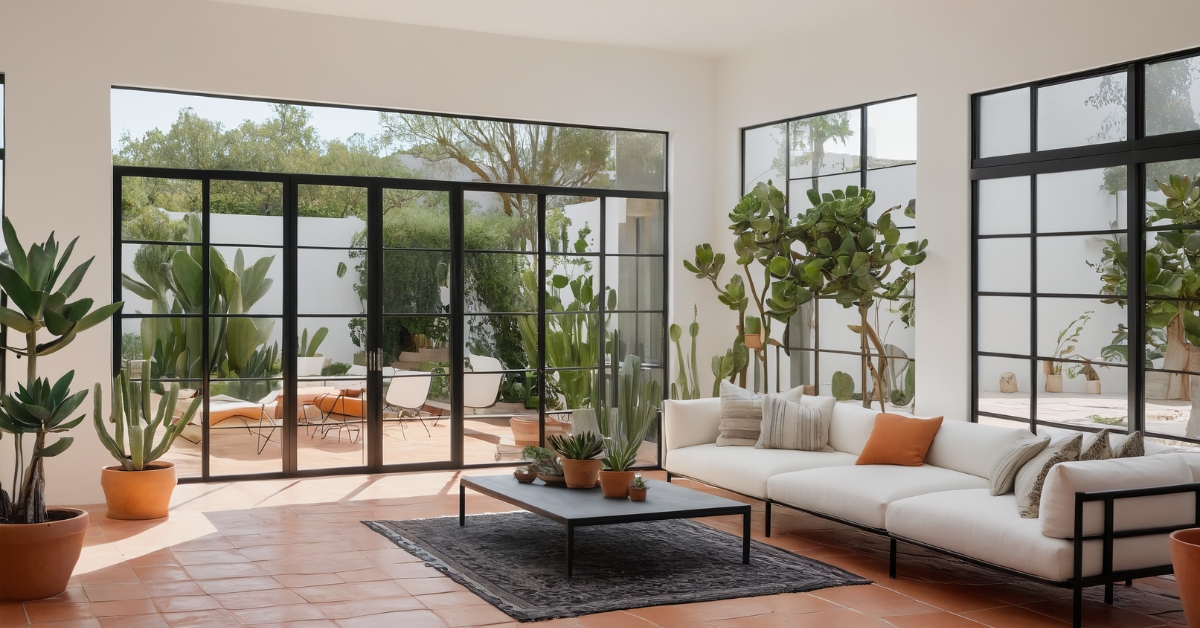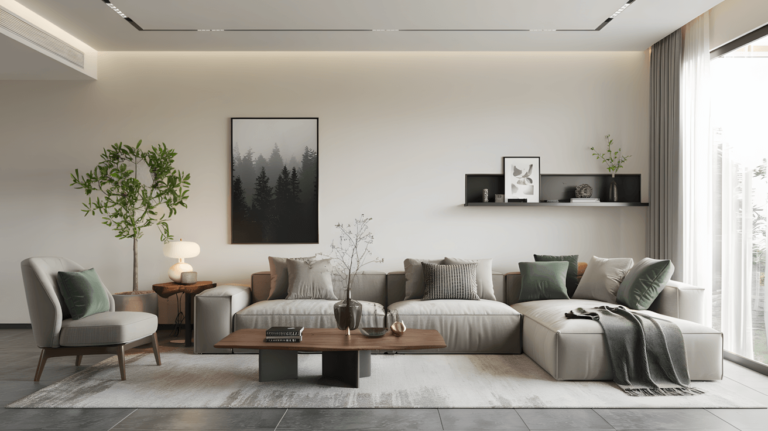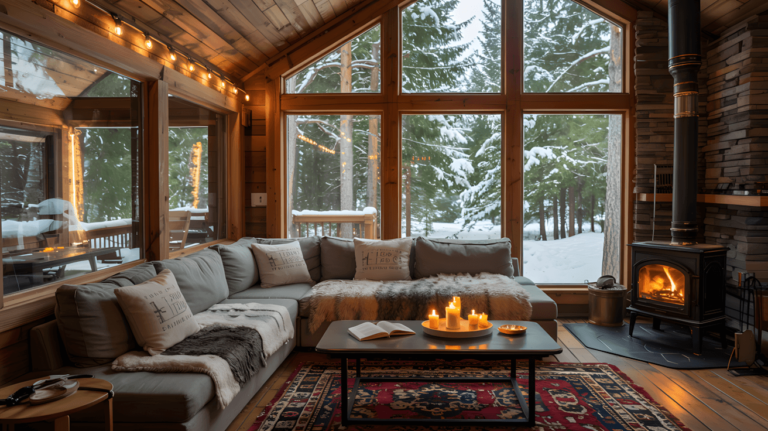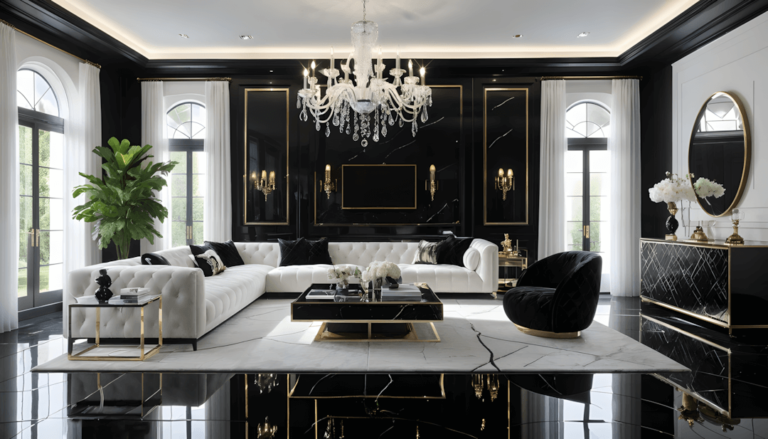After designing over 95 hacienda-style homes in my nine years as an interior consultant specializing in Spanish Colonial and Mediterranean architecture, I’ve discovered that successful modern hacienda interiors require deep understanding of traditional Spanish architectural principles combined with contemporary living needs. The challenge isn’t simply adding rustic elements to modern spaces—it’s creating authentic environments that honor centuries-old building traditions while supporting today’s lifestyles.
What initially drew me to hacienda design was its emphasis on family gathering, indoor-outdoor living, and connection to natural materials. These principles remain as relevant today as they were in 18th-century Spanish colonial settlements. Through extensive projects ranging from authentic adobe restorations to contemporary interpretations in urban settings, I’ve learned that the most successful modern hacienda homes balance traditional craftsmanship with contemporary comfort and technology.
The growing popularity of hacienda style reflects our desire for authenticity and connection to place in an increasingly digital world. Let me share the 21 elements that consistently create the most successful modern hacienda interiors, along with the practical insights I’ve gained from implementing each in real homes.
1. Exposed Wooden Beams: Rustic Grandeur
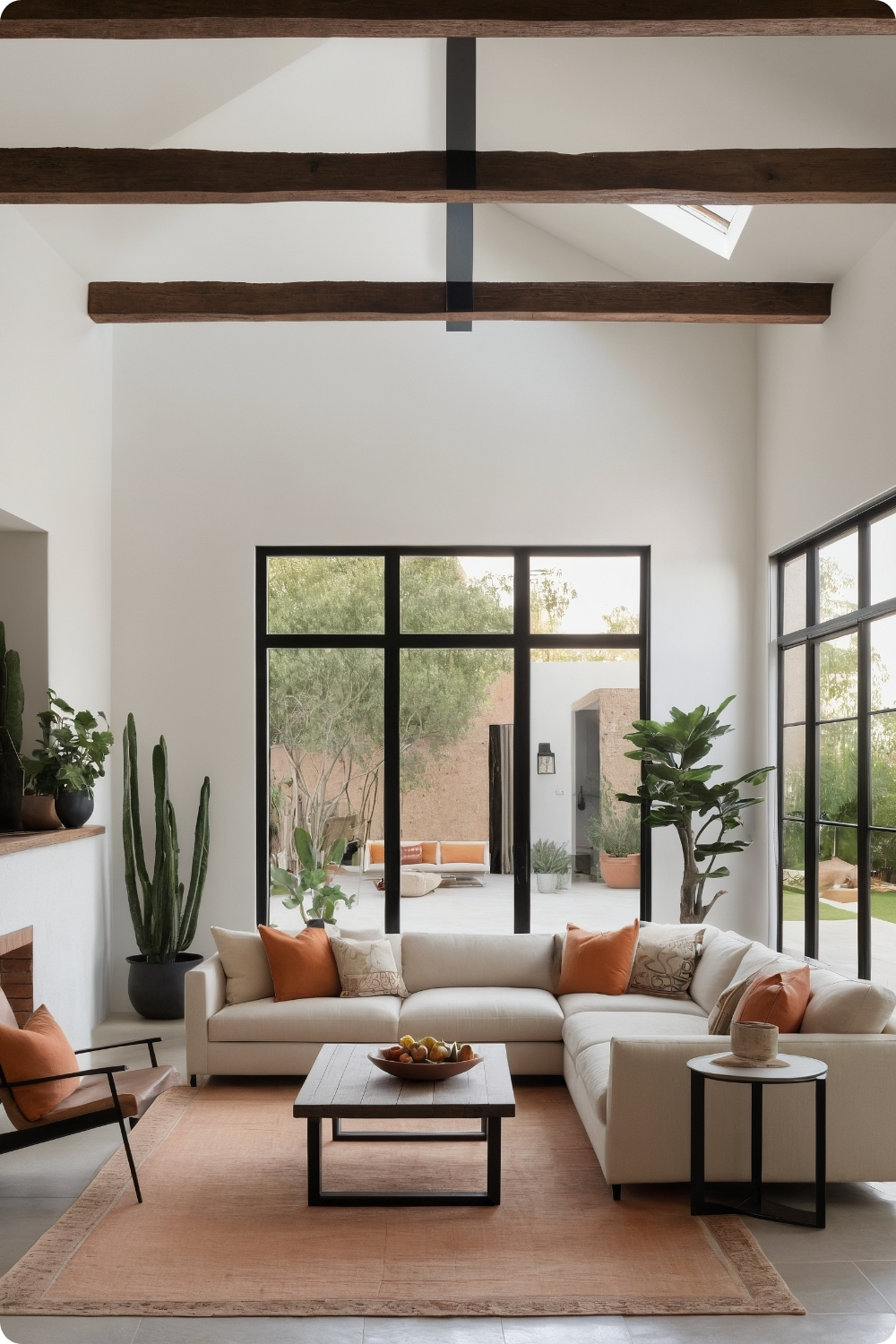
Authentic exposed beams require understanding traditional Spanish construction methods where vigas (rounded log beams) and latillas (smaller branches or planks) served essential structural functions. Modern installations need to honor these proportional relationships while meeting contemporary building codes and load requirements.
I work with structural engineers when installing decorative beams to ensure proper support and safety. The contrast between dark-stained beams and light walls creates dramatic visual impact, but beam sizing must be proportioned correctly—oversized beams in rooms with standard ceiling heights can feel oppressive rather than grand.
The key insight I’ve gained is that authentic beams show natural irregularities and aging patterns that machine-milled lumber lacks. I source reclaimed vigas from demolished historic buildings when possible, or work with specialty suppliers who understand traditional hand-hewn techniques.
For modern interpretations, I pair rustic beams with minimalist furniture and clean lines to create sophisticated contrasts that feel intentional rather than accidentally mismatched. The goal is highlighting the beams’ character while maintaining contemporary functionality.
2. Terracotta Flooring: Earthy Sophistication
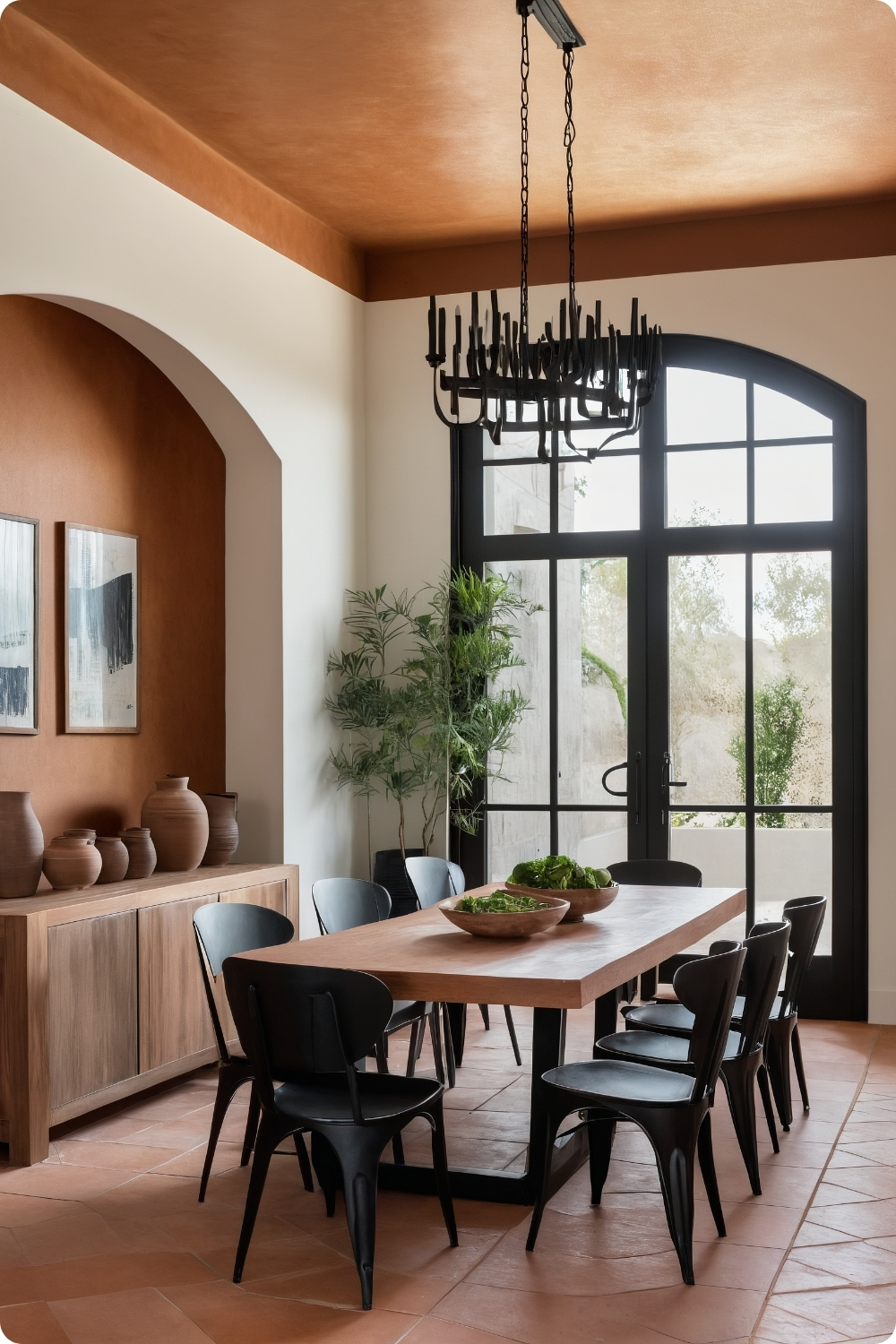
Authentic terracotta tiles were traditionally made from local clay and fired in wood kilns, creating subtle color variations and surface irregularities that mass-produced tiles can’t replicate. I source handmade tiles from artisan producers in Mexico and Spain who maintain traditional techniques and regional clay characteristics.
Modern terracotta installations require understanding thermal expansion, moisture management, and maintenance requirements. These tiles expand and contract significantly with temperature changes, requiring proper expansion joints and sealant maintenance to prevent cracking.
The matte finishes I recommend provide authentic appearance while offering better slip resistance than glossy alternatives. Geometric patterns can work in contemporary interpretations, but they need to reference traditional Spanish tile layouts rather than arbitrary modern designs.
Installation requires experienced tile setters who understand working with handmade materials. The subtle size variations and irregular surfaces demand different techniques than standard commercial tiles, and rushing the installation inevitably compromises the final results.
3. Iron Accents: Strong Yet Elegant
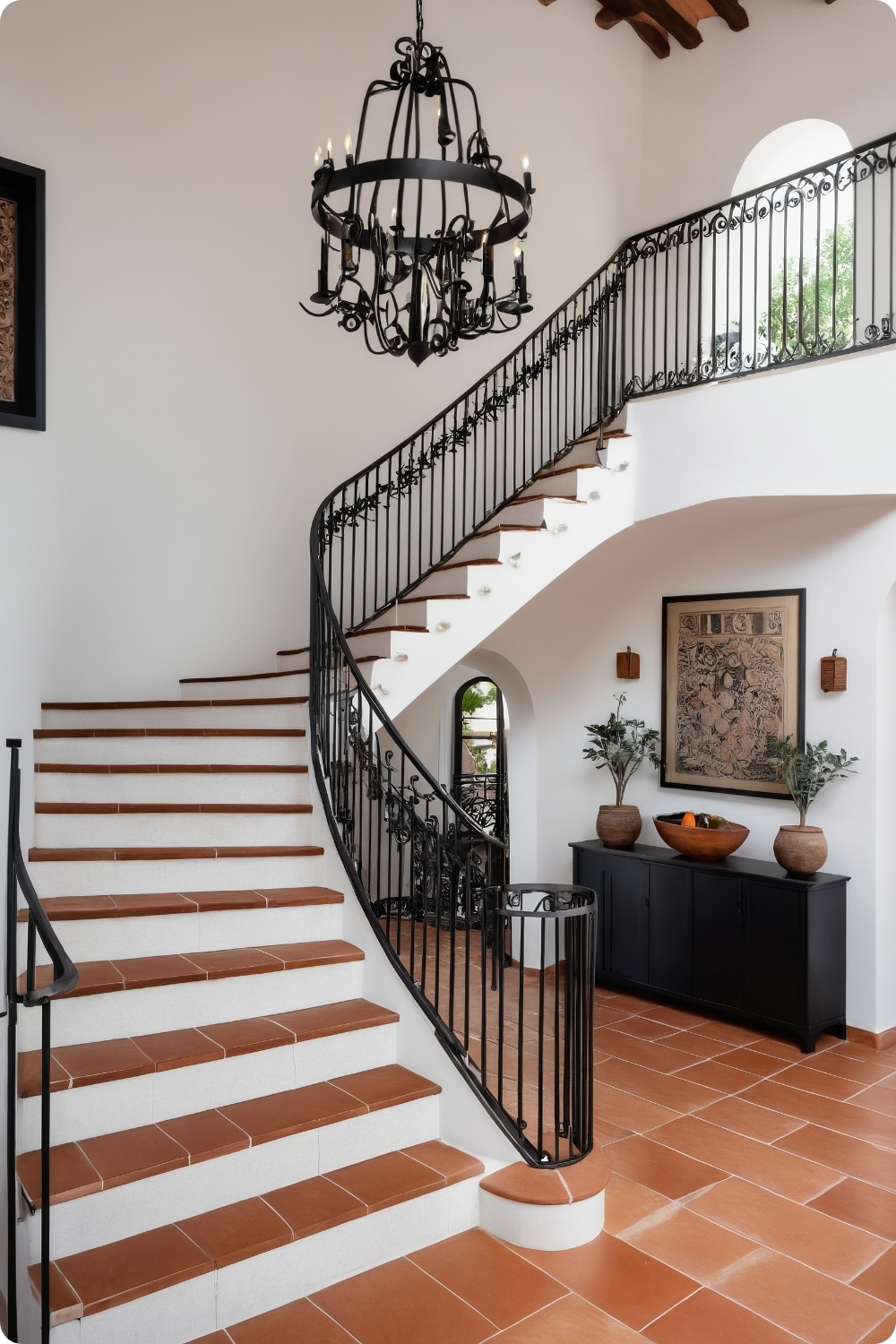
Traditional Spanish ironwork required master craftsmen who understood both functional engineering and decorative artistry. Modern wrought iron work needs to honor these traditions while meeting contemporary safety codes and maintenance requirements.
I work with metalworkers who learned traditional techniques rather than those who simply bend commercial steel rod into decorative shapes. Authentic ironwork shows hammer marks, forge patterns, and joining techniques that machine production can’t replicate.
The placement of iron accents requires understanding their visual weight and scale relationships with other architectural elements. Oversized chandeliers can overwhelm spaces, while undersized hardware appears insignificant against substantial wooden doors and beams.
For contemporary interpretations, I choose clean, minimalist iron designs that reference traditional forms without copying them literally. The goal is maintaining the material’s inherent strength and character while avoiding overly ornate details that can feel costume-like.
4. Whitewashed Walls: Simple & Serene
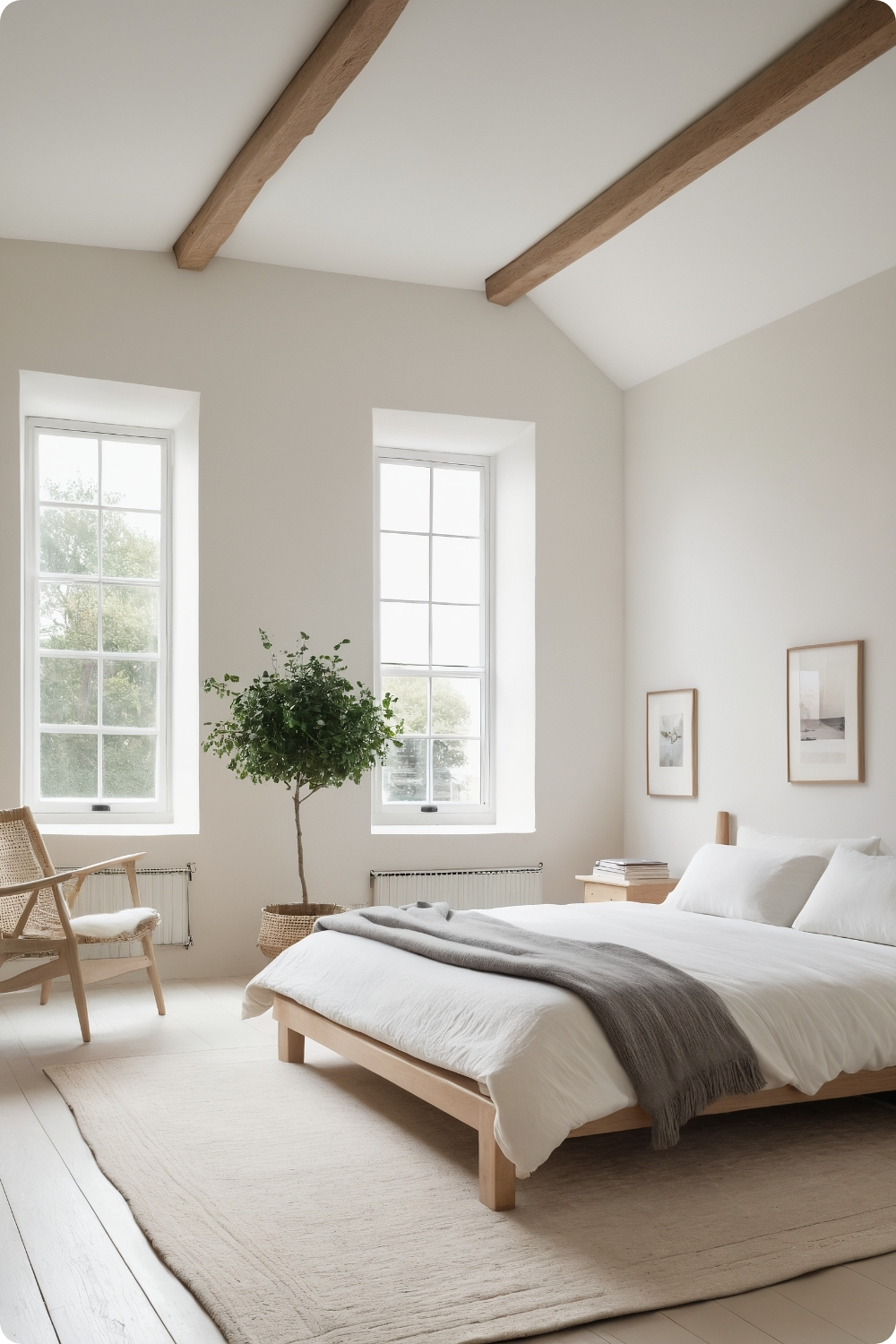
Traditional whitewash was lime-based and created distinctive surface textures and subtle color variations that modern paint can’t replicate. Authentic whitewash techniques require understanding lime chemistry and application methods that few contractors know today.
I work with specialty plasterers who can create convincing whitewash effects using modern materials that provide better durability and code compliance while maintaining authentic appearance. The key is achieving the subtle irregularities and depth that characterize genuine lime plaster.
Textured wall panels can provide similar effects at lower costs, but material selection becomes crucial. Many manufactured textures appear obviously artificial and undermine the authentic aesthetic we’re trying to achieve.
The introduction of cream and beige tones needs to reference natural color variations found in traditional lime plaster rather than arbitrary contemporary color choices. I typically add subtle ochre or umber tints that complement rather than compete with natural materials throughout the space.
5. Arched Doorways: Curves of Character
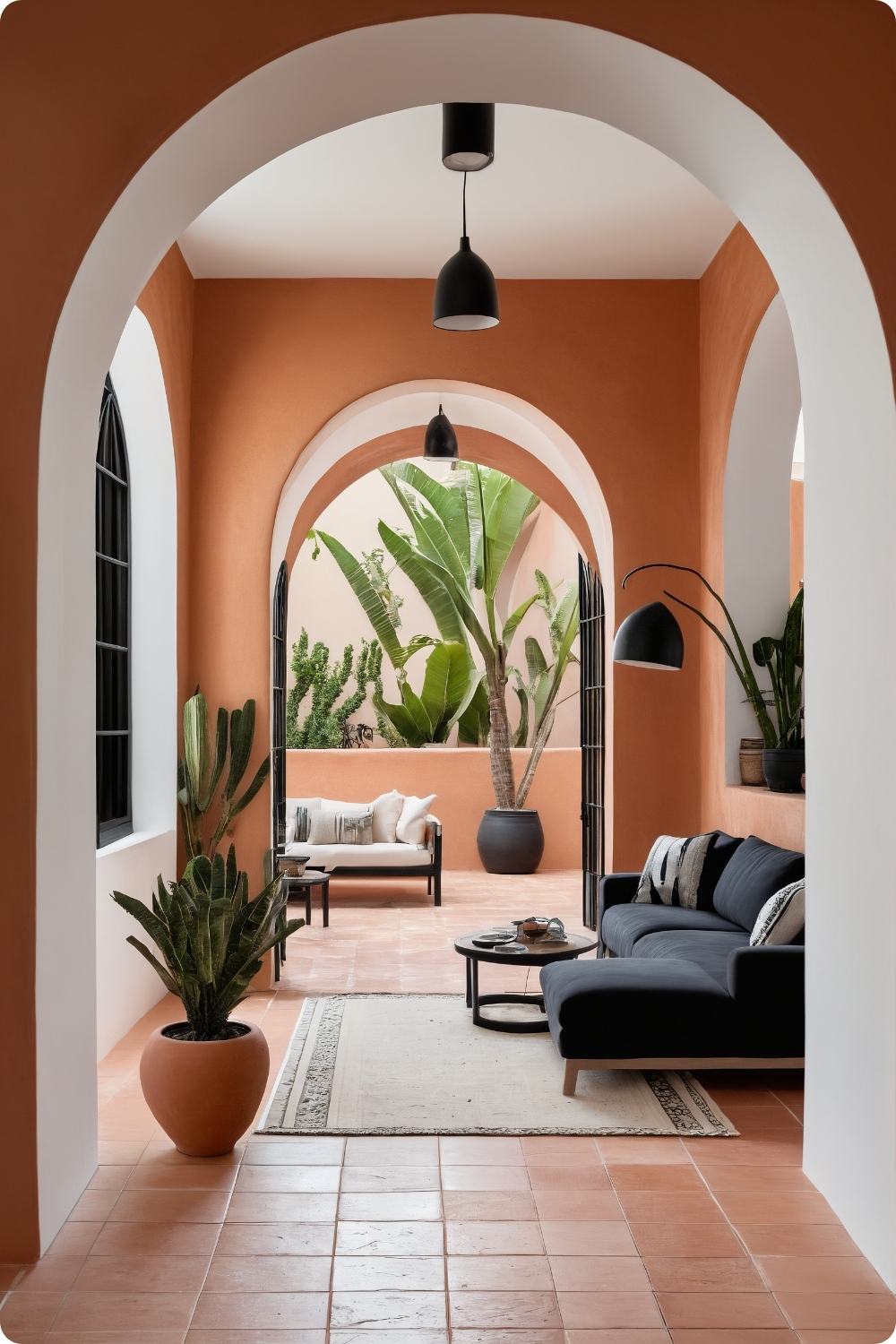
Authentic Spanish arches follow specific proportional relationships developed over centuries of architectural evolution. The width-to-height ratios affect both structural stability and visual harmony, and arbitrary curved openings often feel wrong even when viewers can’t identify why.
Creating arched openings in existing homes requires significant structural work and engineering evaluation. I always involve structural engineers when modifying existing openings to ensure safety and code compliance while maintaining authentic proportions.
The combination of traditional arches with contemporary door frames and hardware requires careful detailing to avoid visual conflicts. I typically choose door hardware that complements rather than competes with the architectural curves.
Modern interpretations can work when they reference traditional proportions while using contemporary materials like steel framing or minimalist detailing. The key is understanding the underlying geometric principles rather than simply copying surface appearances.
6. Handcrafted Furniture: Tradition Meets Innovation
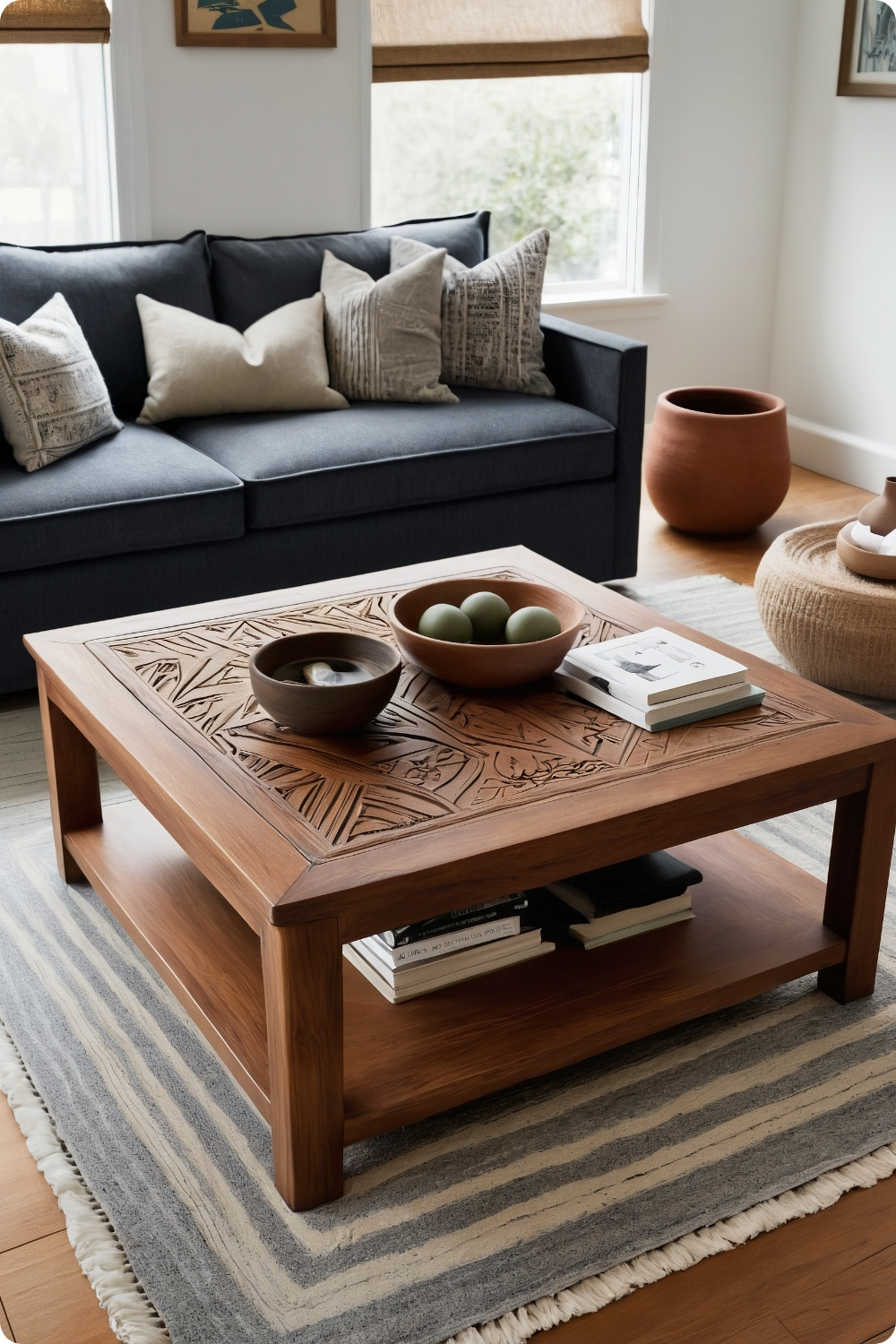
Traditional hacienda furniture was built by local craftsmen using regional wood species and joinery techniques developed over generations. Modern reproductions often lack the subtle proportional relationships and construction details that characterize authentic pieces.
I work with furniture makers who understand traditional Spanish Colonial construction techniques and can create custom pieces that honor historical precedents while meeting contemporary comfort and durability standards.
The patina and aging patterns on authentic antique pieces develop naturally over decades of use and can’t be artificially replicated convincingly. I help clients understand the difference between genuine wear and manufactured “distressing” that often appears obvious and artificial.
For budget-conscious clients, I recommend investing in one or two statement pieces with authentic character while using simpler contemporary furniture that complements rather than competes with the featured pieces.
7. Textured Rugs: Softness Underfoot
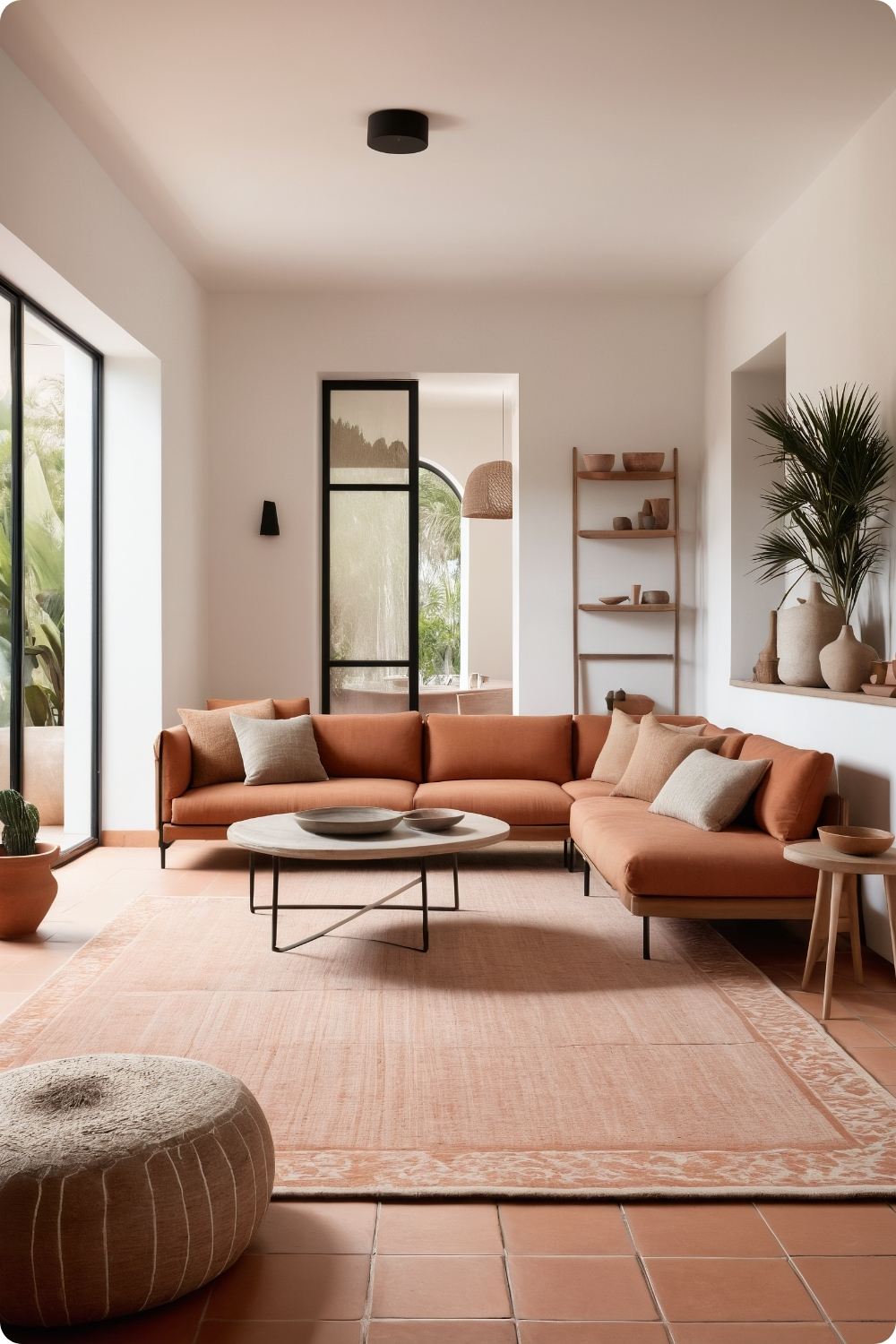
Natural fiber rugs provide essential warmth and softness over hard tile or stone floors, but material selection affects both appearance and durability. Wool ages beautifully and develops character, while synthetic alternatives often appear cheap and wear poorly.
The layering technique requires understanding scale relationships and pattern interactions. I typically use larger, simpler rugs as foundations with smaller, more complex pieces as accents to avoid visual chaos.
Traditional Spanish rug patterns reference Moorish geometric designs or regional textile traditions. Modern interpretations should honor these cultural influences rather than using arbitrary contemporary patterns that lack historical context.
Rug placement affects traffic flow and furniture arrangements, so I plan these installations during space planning rather than treating them as afterthoughts. Proper proportions and positioning significantly impact how spaces feel and function.
8. Neutral Color Palette: Calm & Cozy
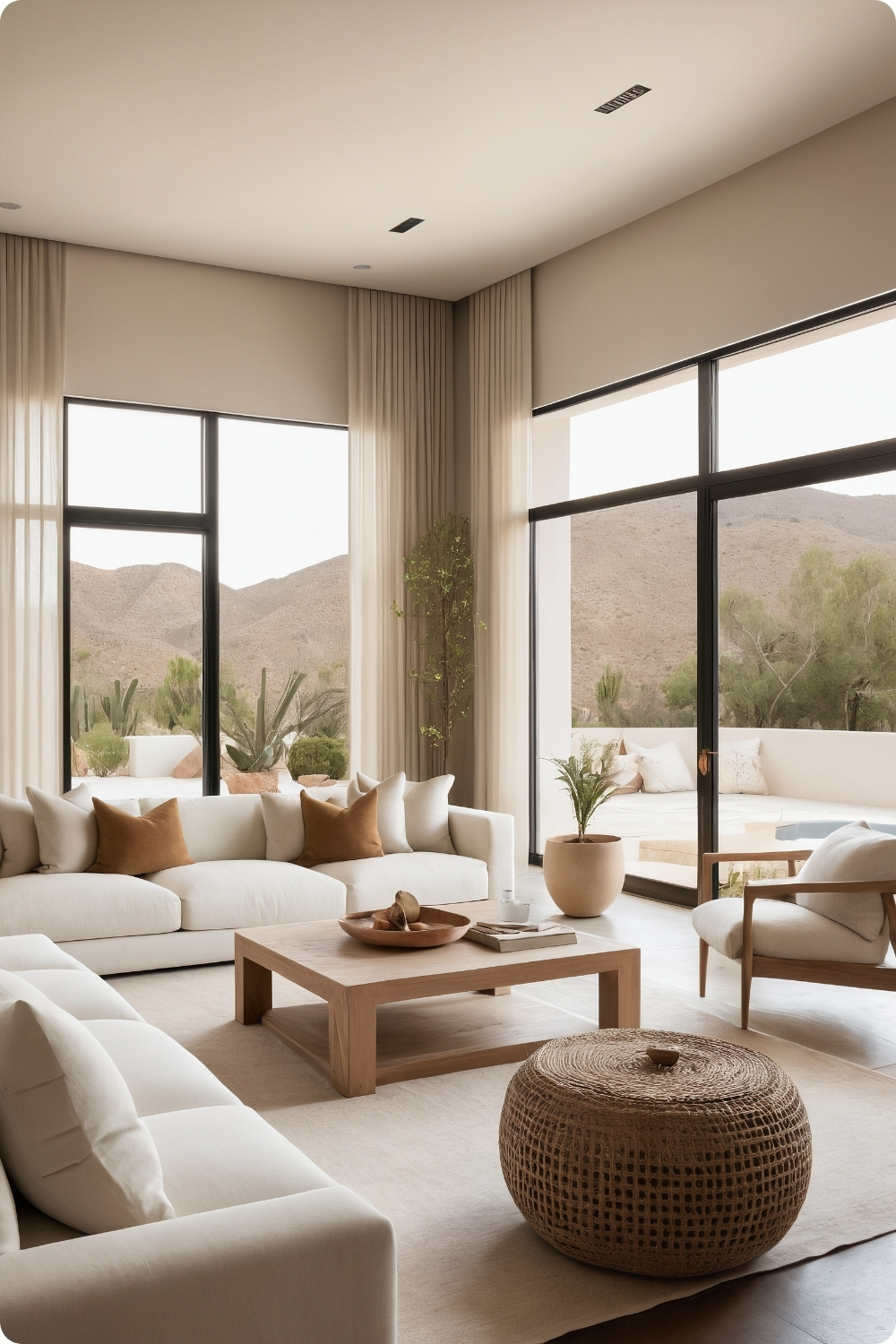
Authentic hacienda color palettes derived from local natural pigments and available materials, which is why traditional Spanish Colonial colors vary by region. New Mexico earth tones differ from California mission colors or Mexican hacienda schemes.
Modern paint formulations often appear too saturated or artificial because they use synthetic pigments that don’t match natural mineral colors. I work with specialty paint companies that create custom colors using natural earth pigments for authentic depth and variation.
The addition of gold or copper accents needs to reference traditional metalwork rather than contemporary design trends. These warm metals complement earth-tone palettes because they share similar underlying color temperatures.
Layering multiple neutral tones within the same color family creates visual richness while maintaining the calm, serene atmosphere that makes hacienda interiors so appealing for relaxation and contemplation.
9. Fireplaces: Centerpiece of Comfort
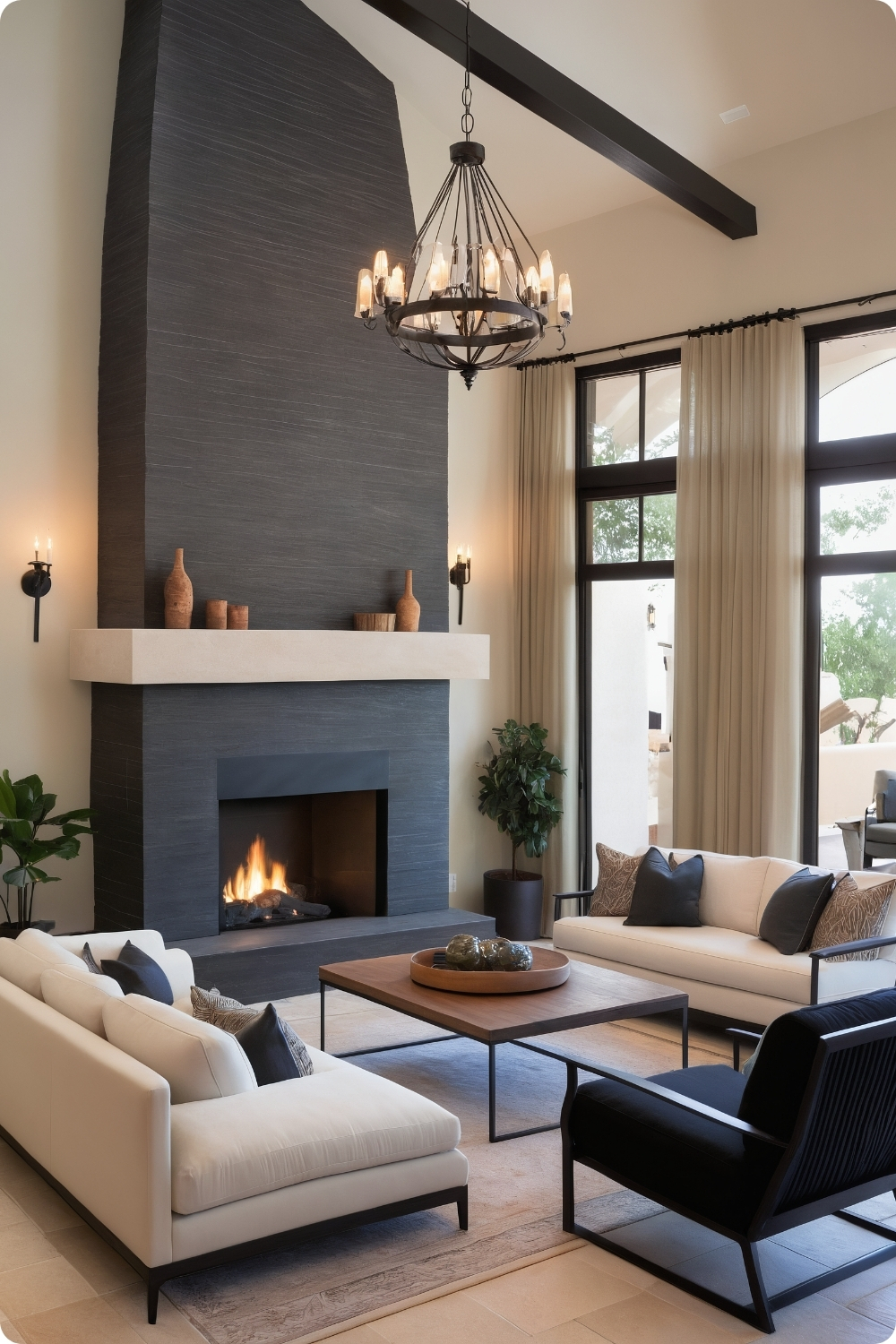
Traditional hacienda fireplaces were essential for cooking and heating, often featuring large openings and substantial masonry construction. Modern interpretations need to balance this grand scale with contemporary heating efficiency and safety requirements.
Stone surrounds require understanding regional stone characteristics and traditional masonry techniques. I source stone from quarries in areas with Spanish Colonial history when possible to maintain authentic material connections.
Minimalist mantels can work in contemporary interpretations, but they need proper proportional relationships with the fireplace opening and surrounding architecture. Undersized mantels often appear insignificant against substantial masonry surrounds.
The styling around fireplaces requires restraint—simple ceramics and greenery honor traditional approaches while avoiding cluttered arrangements that compete with the architectural focal point.
10. Colorful Accents: A Splash of Vibrance
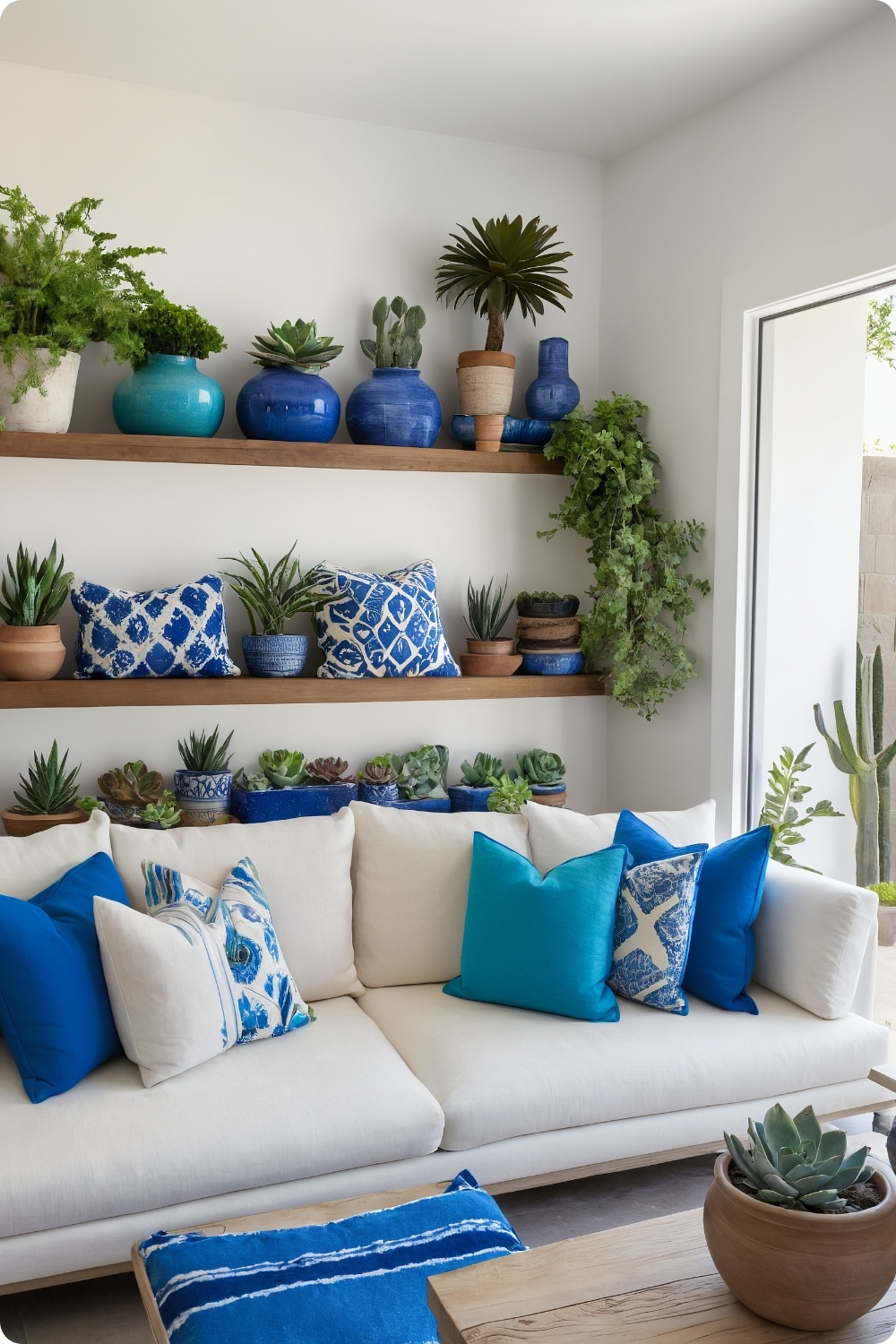
Traditional Spanish Colonial interiors included vibrant colors through textiles, ceramics, and painted details, but these colors followed specific cultural and regional traditions rather than arbitrary contemporary choices.
Bold blues and reds reference traditional Spanish ceramic glazes and textile dyes that have cultural significance and historical precedent. Random bright colors without cultural context can feel superficial and inappropriate.
The placement of colorful accents requires understanding visual weight and balance. I typically distribute color throughout spaces rather than concentrating it in single locations to maintain visual harmony.
Ceramic planters and pottery provide opportunities to introduce authentic colors and patterns while serving practical functions. I source these from artisan producers who maintain traditional techniques rather than mass-market suppliers.
11. Statement Lighting: Drama & Warmth
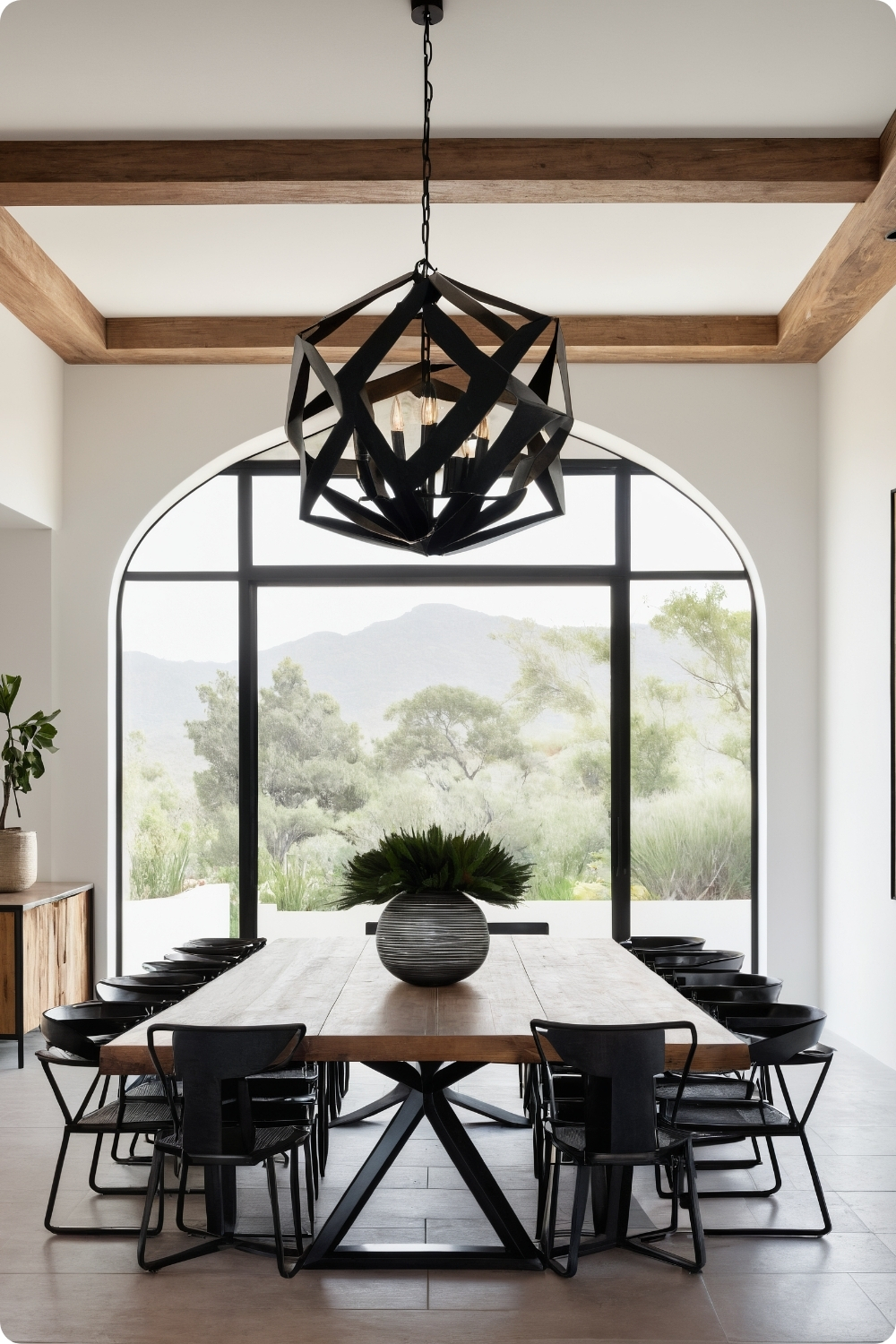
Large iron chandeliers create dramatic focal points, but sizing requires understanding room proportions and ceiling heights. Oversized fixtures can overwhelm spaces, while undersized pieces appear insignificant against substantial architecture.
Traditional Spanish Colonial lighting used candles and oil lamps, creating warm, intimate illumination that modern electric fixtures need to replicate. I choose bulbs with warm color temperatures and often include dimming controls for ambiance flexibility.
Geometric designs in modern chandeliers can work when they reference traditional Spanish ironwork patterns rather than arbitrary contemporary forms. The key is maintaining material authenticity while updating proportions and detailing.
Rustic lanterns and pendant lights provide accent lighting while reinforcing the handcrafted aesthetic that defines authentic hacienda interiors.
12. Built-In Niches: Functionality Meets Art
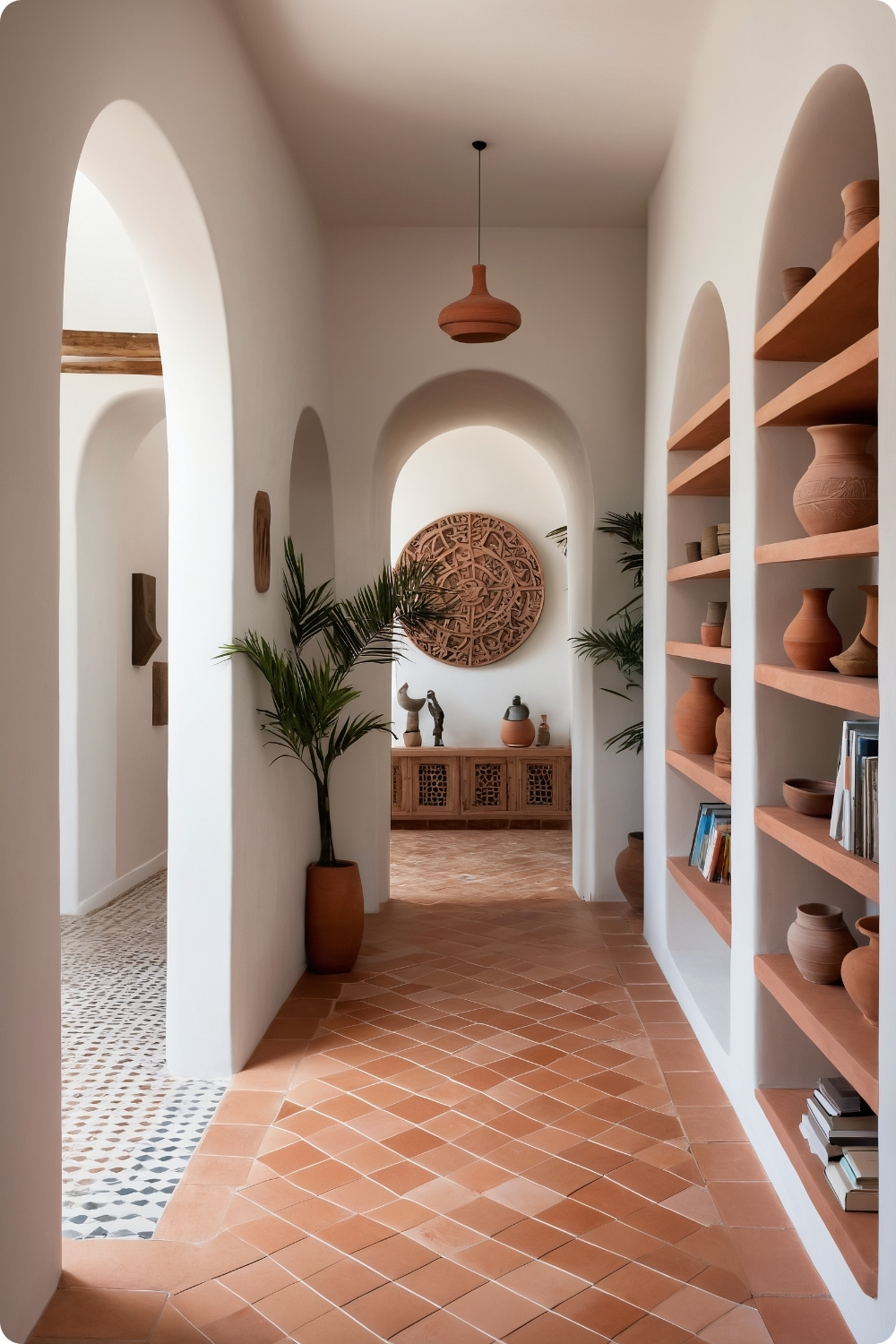
Traditional Spanish Colonial architecture included built-in niches for religious statuary and practical storage, creating architectural interest while serving functional needs. Modern interpretations need to honor these proportional relationships and cultural contexts.
The depth and sizing of niches affects both their practical utility and visual impact. Shallow niches work for displaying flat objects but can’t accommodate sculptural pieces, while deep niches may appear as dark holes without proper lighting.
Clean, minimalist detailing works in contemporary hacienda homes when it maintains the essential architectural character while avoiding unnecessary ornamentation. The goal is highlighting displayed objects rather than competing with them.
Lighting within niches requires careful planning to avoid harsh shadows while providing adequate illumination for displayed items. I typically use LED strip lights with warm color temperatures for even, flattering illumination.
13. Clay Pottery: Artisanal Elegance
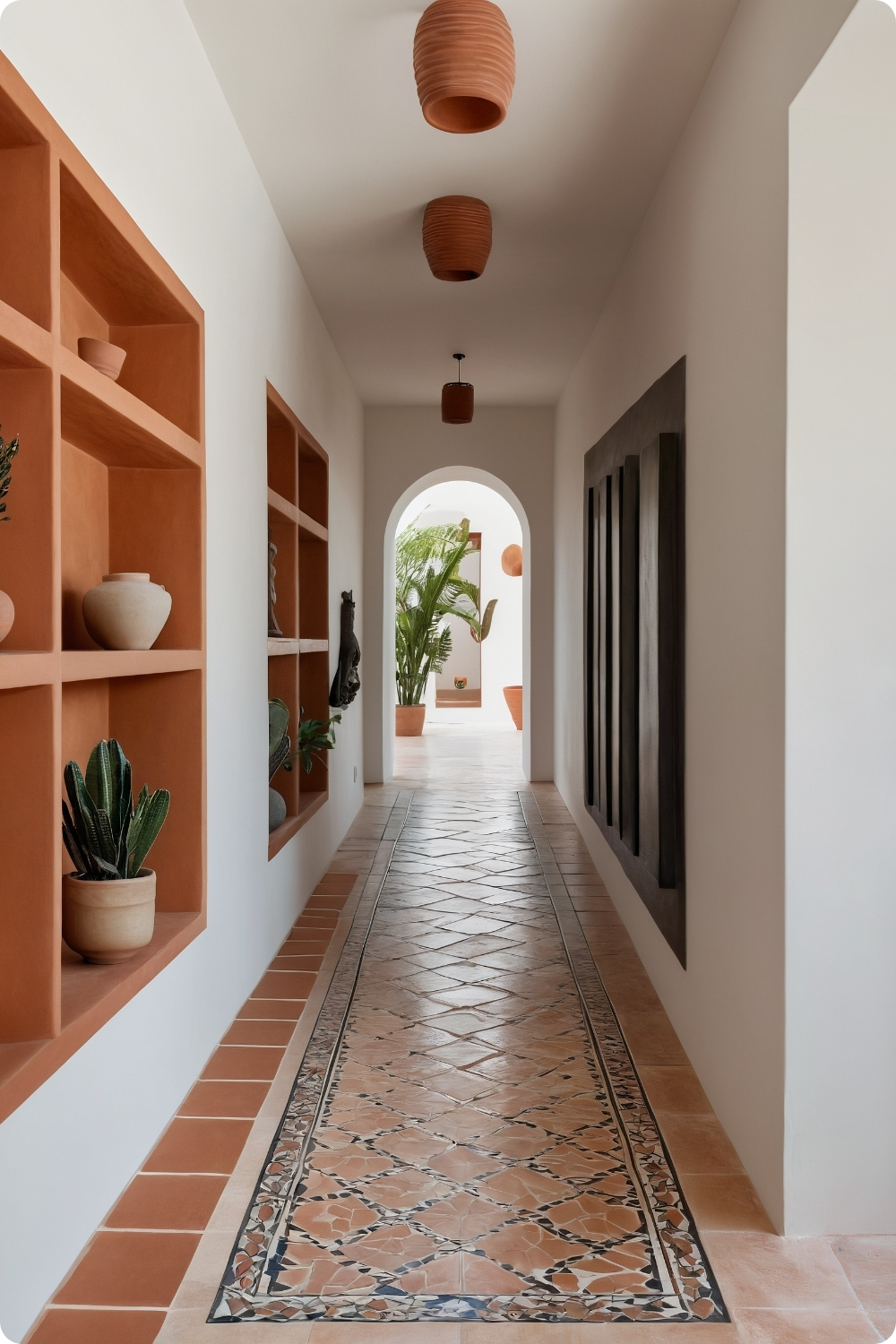
Authentic handmade pottery shows subtle irregularities and surface variations that machine production can’t replicate. I source pottery from artisan producers who maintain traditional techniques and regional clay characteristics.
Contemporary shapes and designs can work in modern hacienda interiors when they honor traditional proportions and surface treatments rather than following arbitrary fashion trends. The key is maintaining the handmade quality that defines authentic craft.
The display of pottery requires understanding scale relationships and visual balance. Large pieces work as sculptural focal points, while smaller items need grouping strategies that create cohesive compositions.
The functional use of pottery for plants and storage connects modern homes with traditional hacienda lifestyles where handmade ceramics served essential daily needs.
14. Natural Fabrics: Soft Yet Durable
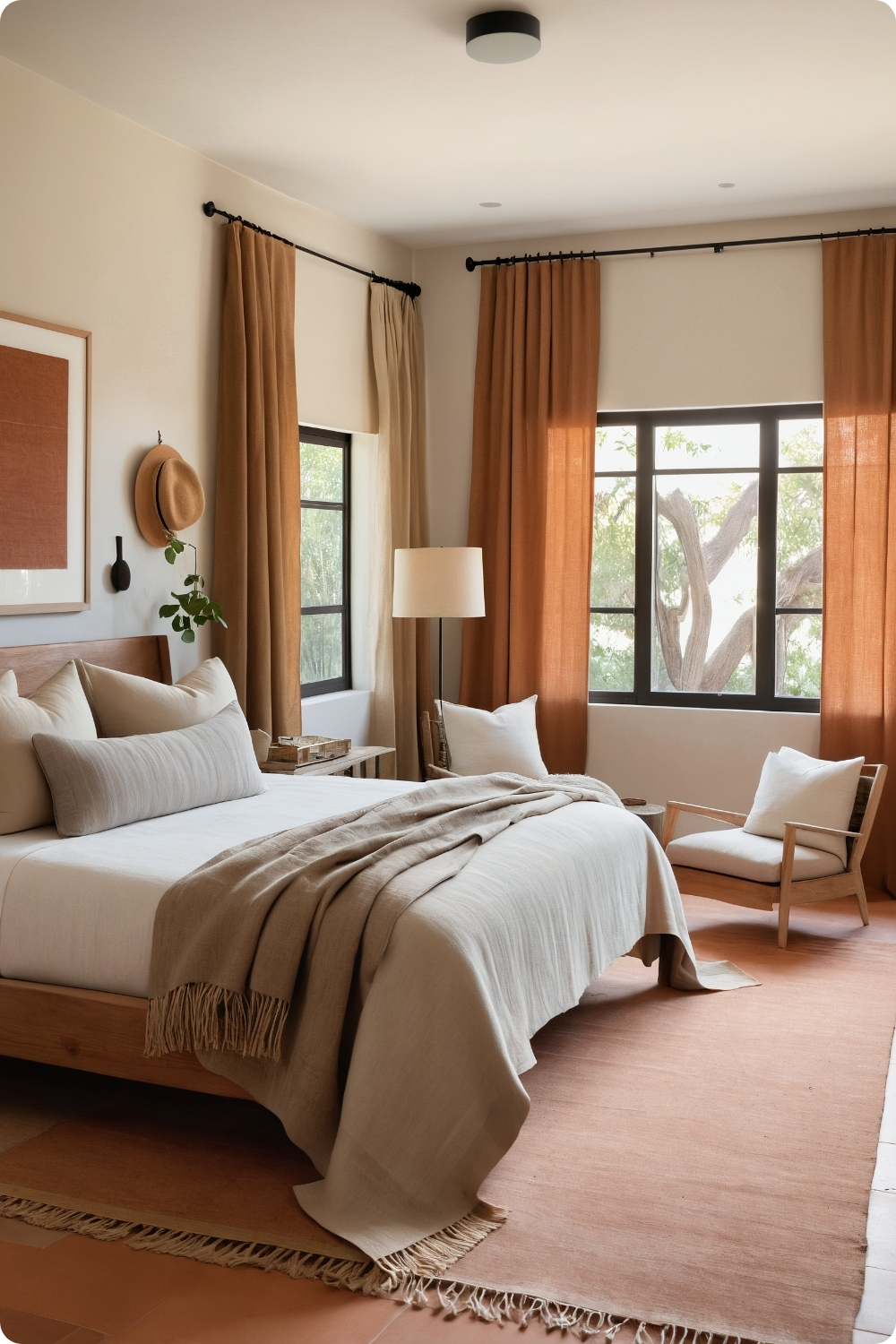
Traditional Spanish Colonial textiles used locally available fibers and natural dyes, creating distinctive regional characteristics that mass-produced fabrics can’t replicate. I source fabrics from suppliers who understand traditional weaving techniques and fiber preparation.
Linen, wool, and cotton age beautifully and develop character over time, while synthetic alternatives often appear cheap and wear poorly. The initial investment in natural fibers pays off in longevity and improving appearance over years of use.
Color palettes in natural fabrics need to complement earth-tone architectural backgrounds while providing enough contrast for visual interest. I typically choose warm whites, creams, and natural fiber colors that enhance rather than compete with architectural elements.
The draping and styling of natural fabrics requires understanding their inherent characteristics—linen wrinkles naturally and shouldn’t be forced into crisp, formal arrangements that fight its relaxed nature.
15. Open-Concept Layouts: Space to Breathe
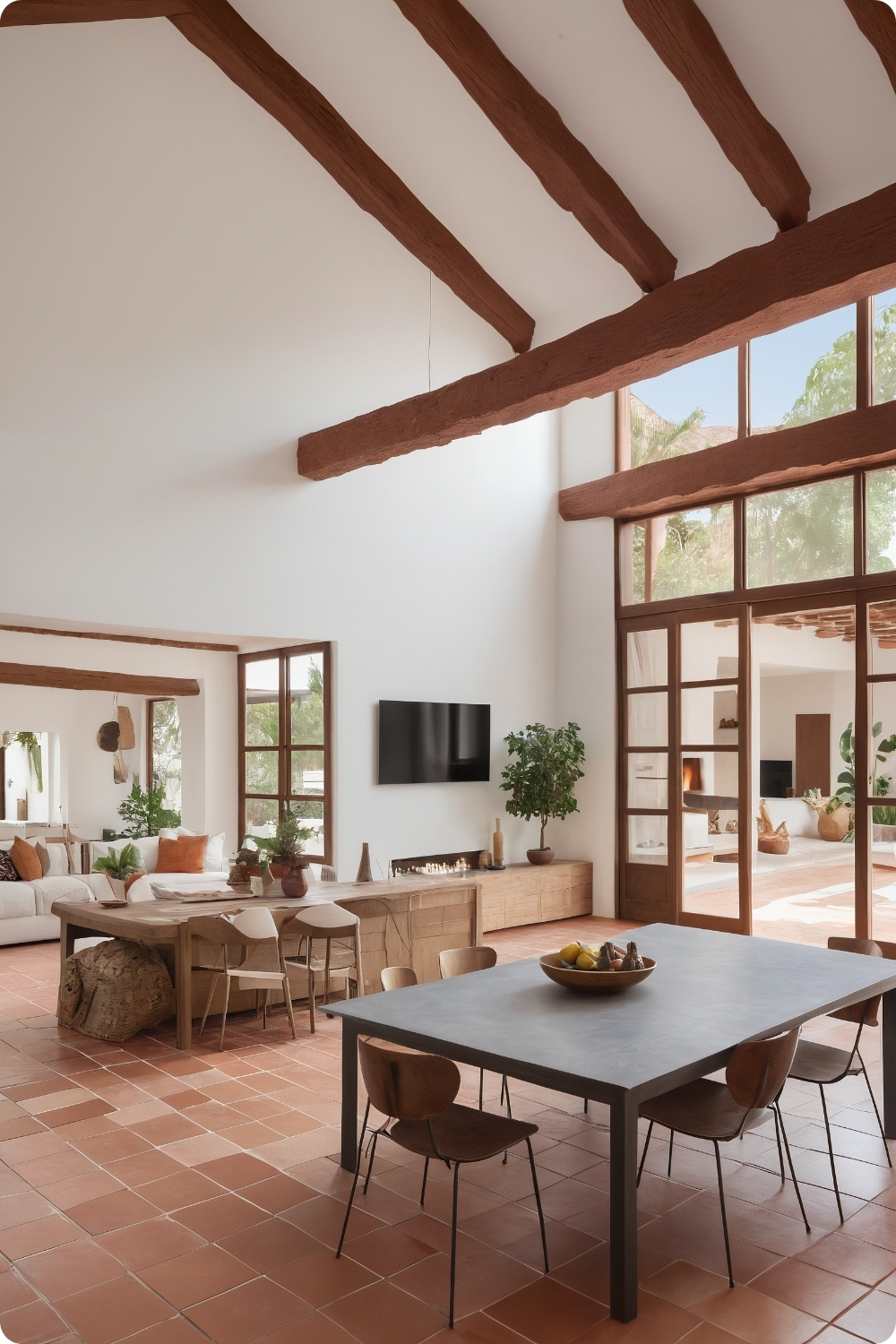
Traditional hacienda layouts centered around courtyards with rooms opening onto covered porches and common areas. Modern open-concept interpretations need to maintain this sense of connection while providing necessary privacy and functionality.
The flow between spaces requires careful planning to ensure smooth transitions while maintaining distinct functional zones. I use furniture arrangement, ceiling treatments, and flooring changes to define areas without creating physical barriers.
Maintaining warmth and coziness in large, open spaces requires understanding scale relationships and material selections. Large spaces can feel cold without proper proportions and material warmth.
The integration of kitchen, dining, and living areas needs to support both daily family life and entertaining while maintaining the authentic hacienda emphasis on communal gathering and shared meals.
16. Large Windows: Bringing the Outdoors In
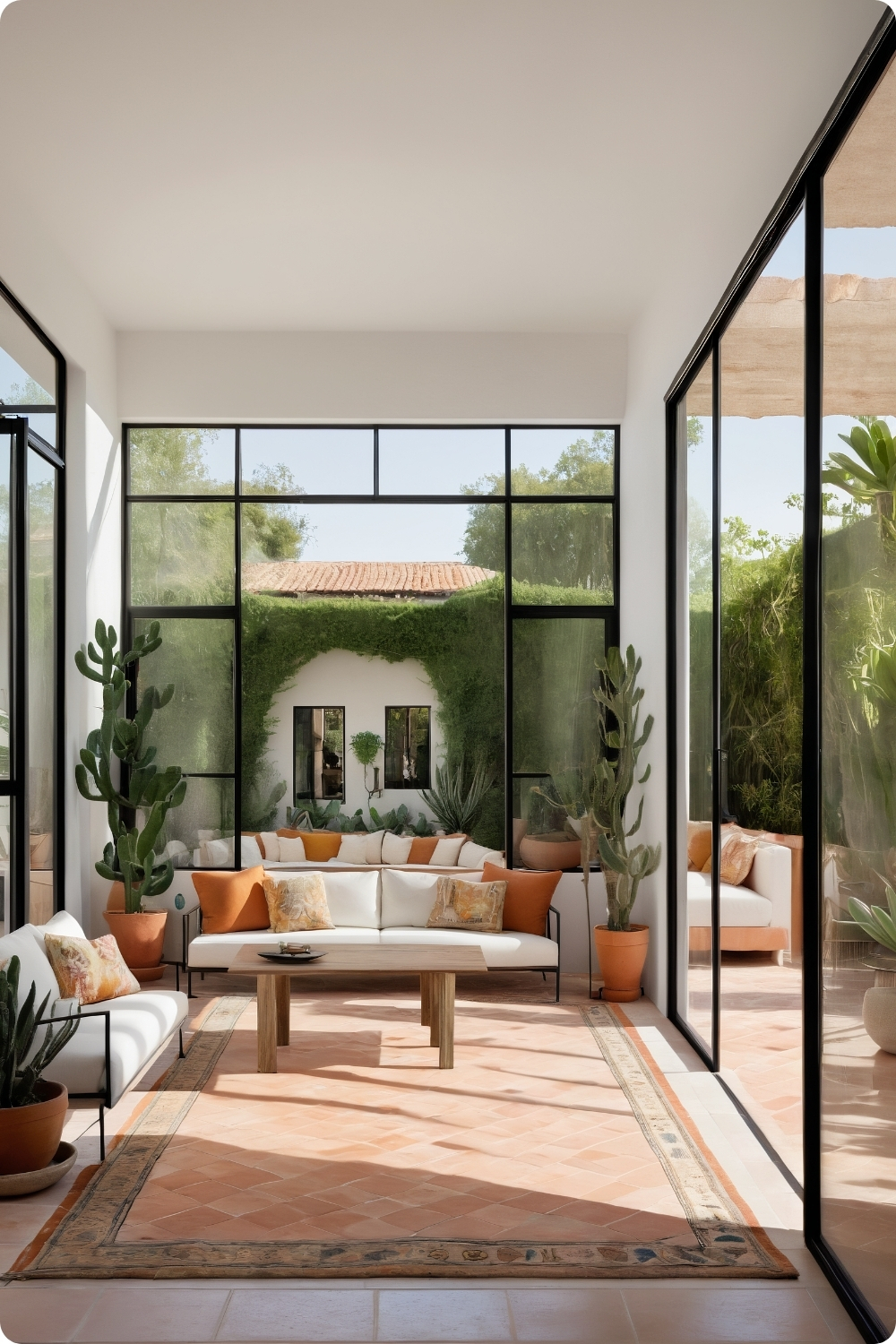
Traditional Spanish Colonial windows were often smaller due to structural limitations and climate control needs, but modern interpretations can embrace larger openings while maintaining authentic proportional relationships and framing details.
Black-framed windows provide contemporary sophistication while referencing traditional iron casement windows used in Spanish Colonial architecture. The frames need proper proportions and detailing to appear authentic rather than arbitrary.
The orientation and sizing of windows affects both natural light and energy efficiency. I work with architects to optimize window placement for specific site conditions and regional climate requirements.
The integration of window treatments needs to complement both interior and exterior architectural details while providing necessary privacy and light control for modern living needs.
17. Bold Tiles: Modern Meets Tradition
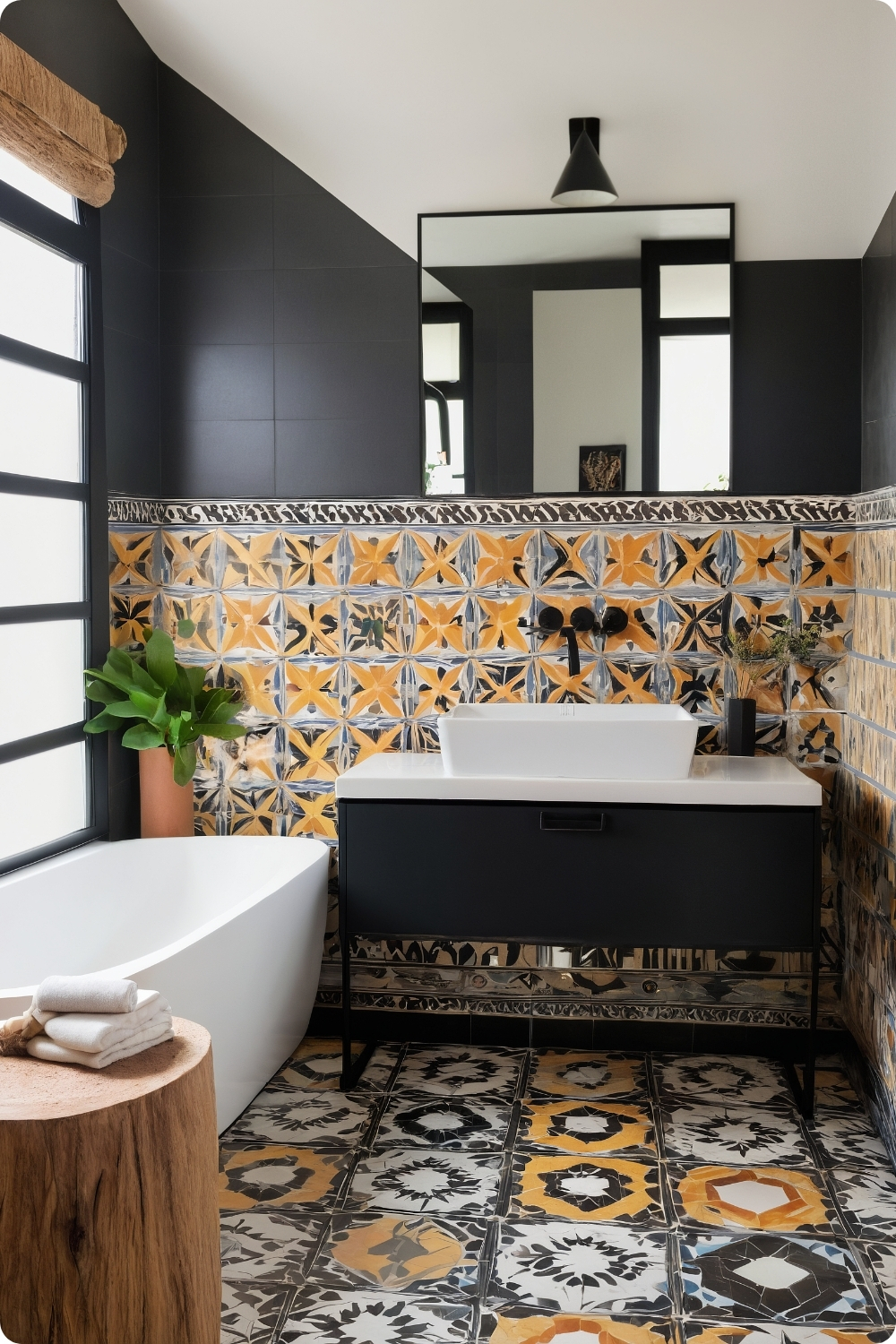
Decorative tiles in kitchens and bathrooms reference centuries-old Spanish ceramic traditions, but modern interpretations need to honor traditional patterns and color relationships rather than following arbitrary contemporary trends.
Monochromatic tile schemes can work in contemporary hacienda homes when they use traditional shapes and installation patterns that reference historical precedents while simplifying color palettes.
The installation of decorative tiles requires experienced craftspeople who understand pattern relationships and proper proportions. Poor installation can destroy even the most beautiful tiles.
Quality differences between handmade and machine-made tiles significantly affect both appearance and longevity. The investment in authentic handcrafted tiles pays off in character and durability that mass-produced alternatives can’t match.
18. Outdoor Courtyards: Extension of the Home
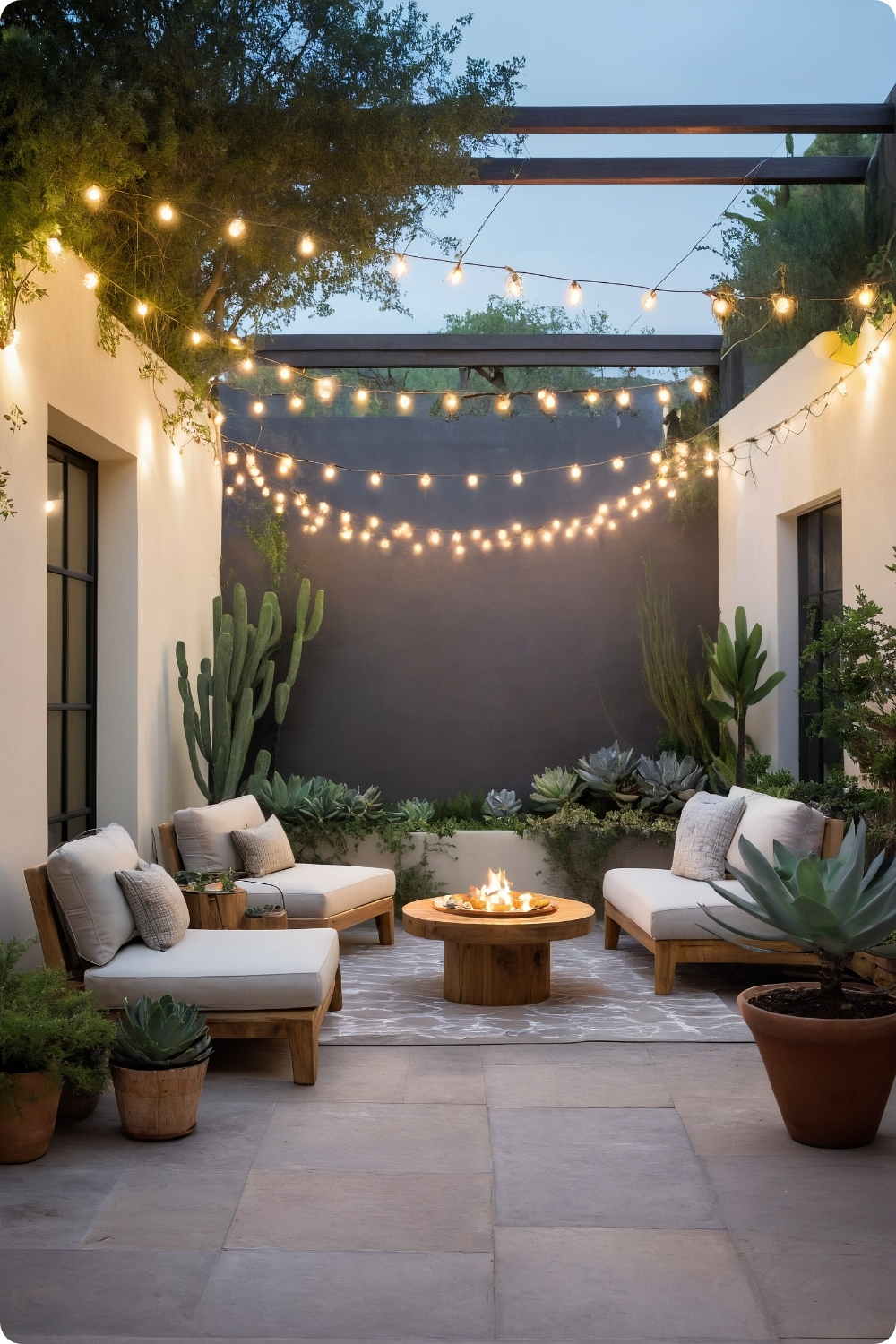
Traditional hacienda courtyards served as outdoor living rooms where families gathered for meals, work, and socializing. Modern interpretations need to maintain this emphasis on outdoor living while incorporating contemporary comfort and entertainment needs.
The integration between indoor and outdoor spaces requires understanding climate conditions, prevailing winds, and seasonal use patterns. Design decisions that work in temperate climates may be inappropriate in areas with extreme weather.
Modern outdoor furniture needs to withstand weather exposure while maintaining authentic aesthetic character. I choose materials and finishes that age gracefully rather than deteriorating or requiring constant maintenance.
String lights and planted areas create ambiance while referencing traditional Spanish Colonial courtyard treatments. The key is achieving intimate scale within larger outdoor spaces.
19. Wooden Shutters: Functional & Stylish
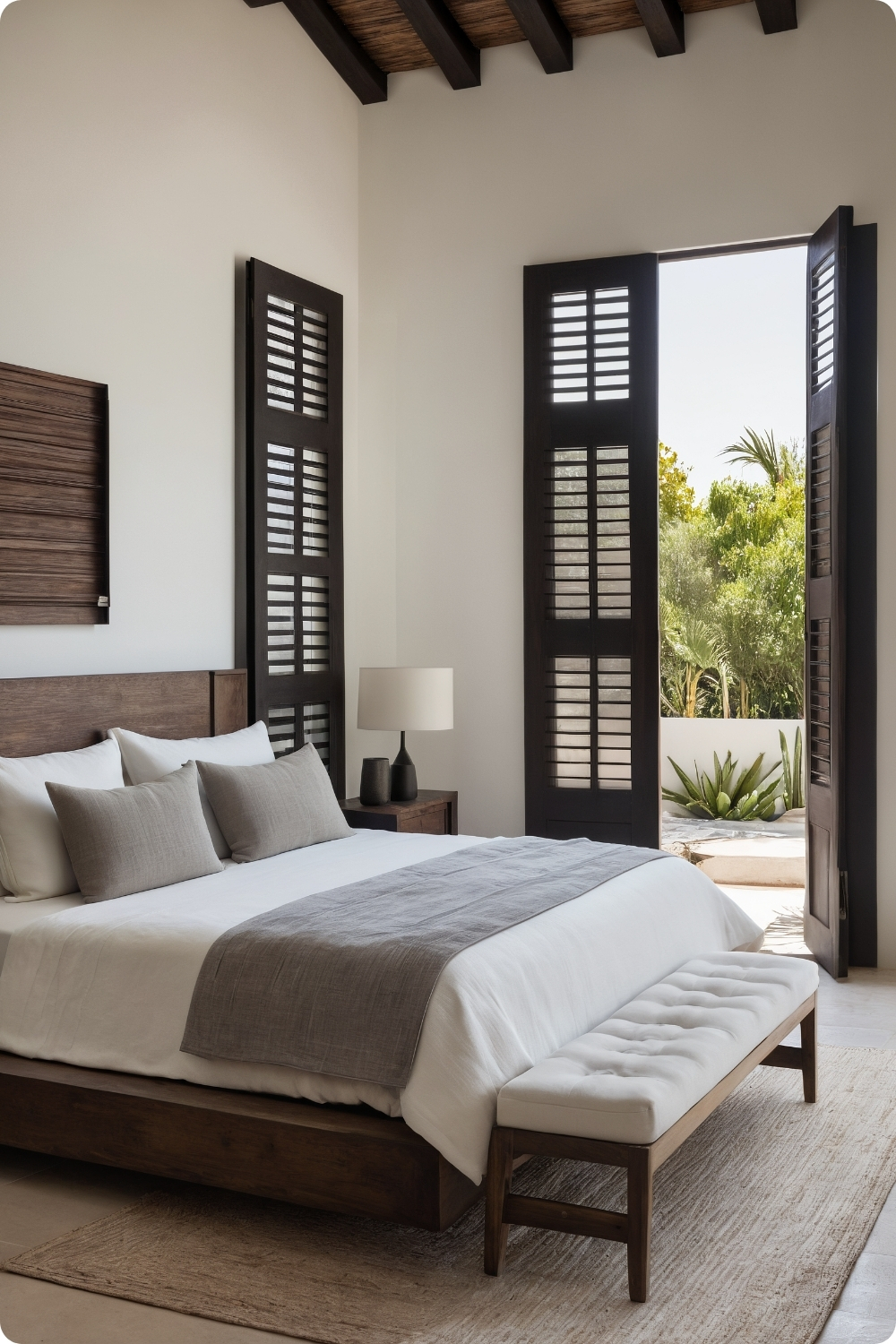
Traditional Spanish Colonial shutters provided security, privacy, and climate control while adding architectural character. Modern shutters need to serve similar functions while meeting contemporary performance and maintenance requirements.
Clean lines and minimalist finishes can work in modern hacienda homes when they maintain proper proportions and installation details that reference traditional construction methods.
Darker wood tones provide sophisticated alternatives to traditional natural finishes while maintaining the essential character of wooden shutters. The key is choosing tones that complement rather than compete with other architectural elements.
The hardware and installation methods affect both function and appearance. Quality hinges and mounting systems ensure smooth operation while maintaining authentic visual character.
20. Greenery: Lush and Natural
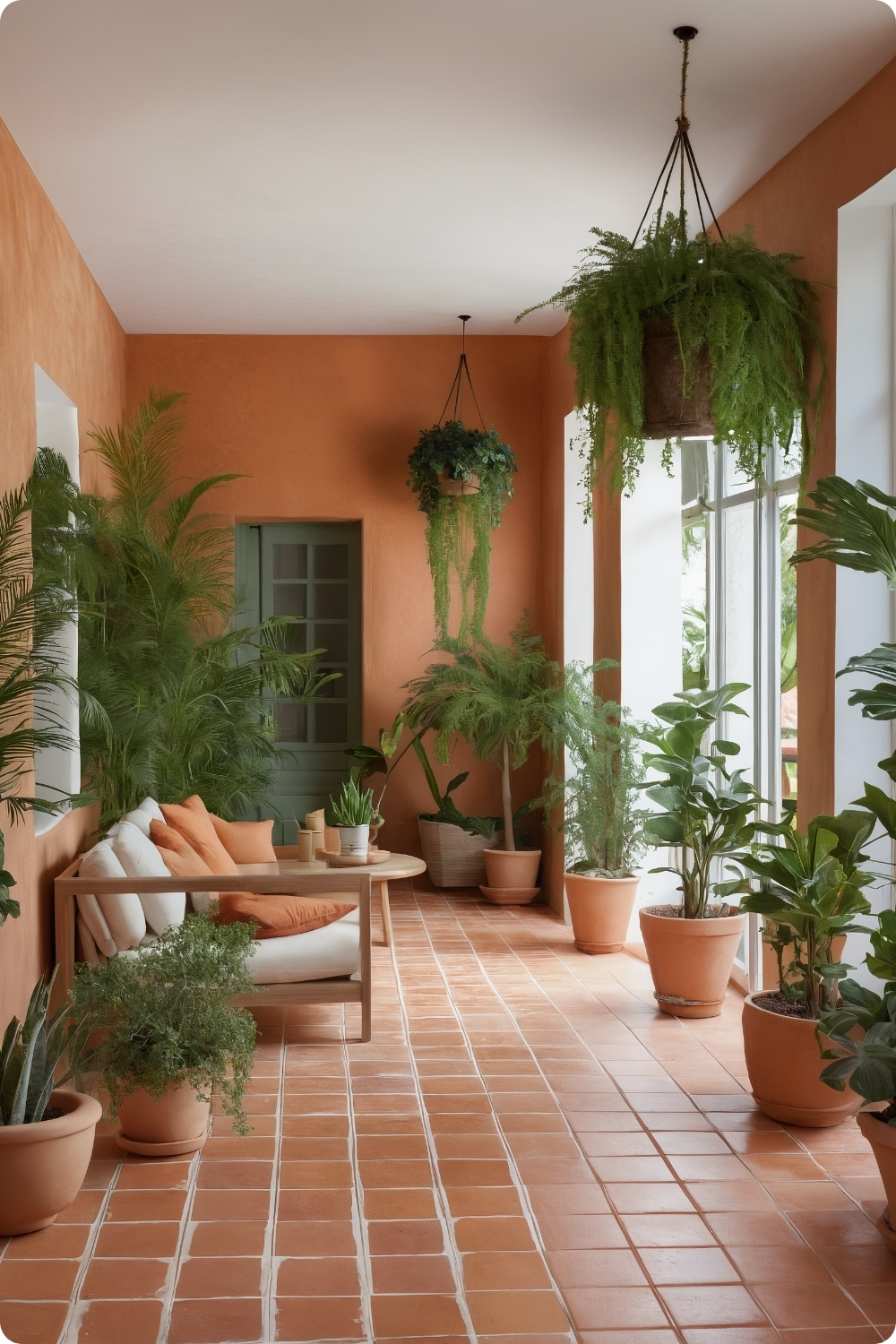
Traditional hacienda gardens included both ornamental and practical plants—herbs for cooking, citrus for fruit, and flowering plants for beauty. Modern interpretations can maintain this integration of useful and beautiful plants.
Potted plants provide flexibility for seasonal changes and climate control while referencing traditional Spanish Colonial gardening practices where containers allowed plant protection during harsh weather.
Indoor trees like olive or citrus connect modern homes with traditional hacienda agriculture while providing sculptural interest and air quality benefits. These plants require understanding their specific light and care requirements.
The selection of plant varieties should reference regional traditions and climate adaptation rather than following arbitrary contemporary plant trends that may be inappropriate for authentic hacienda aesthetics.
21. Art: Clean and Thoughtful
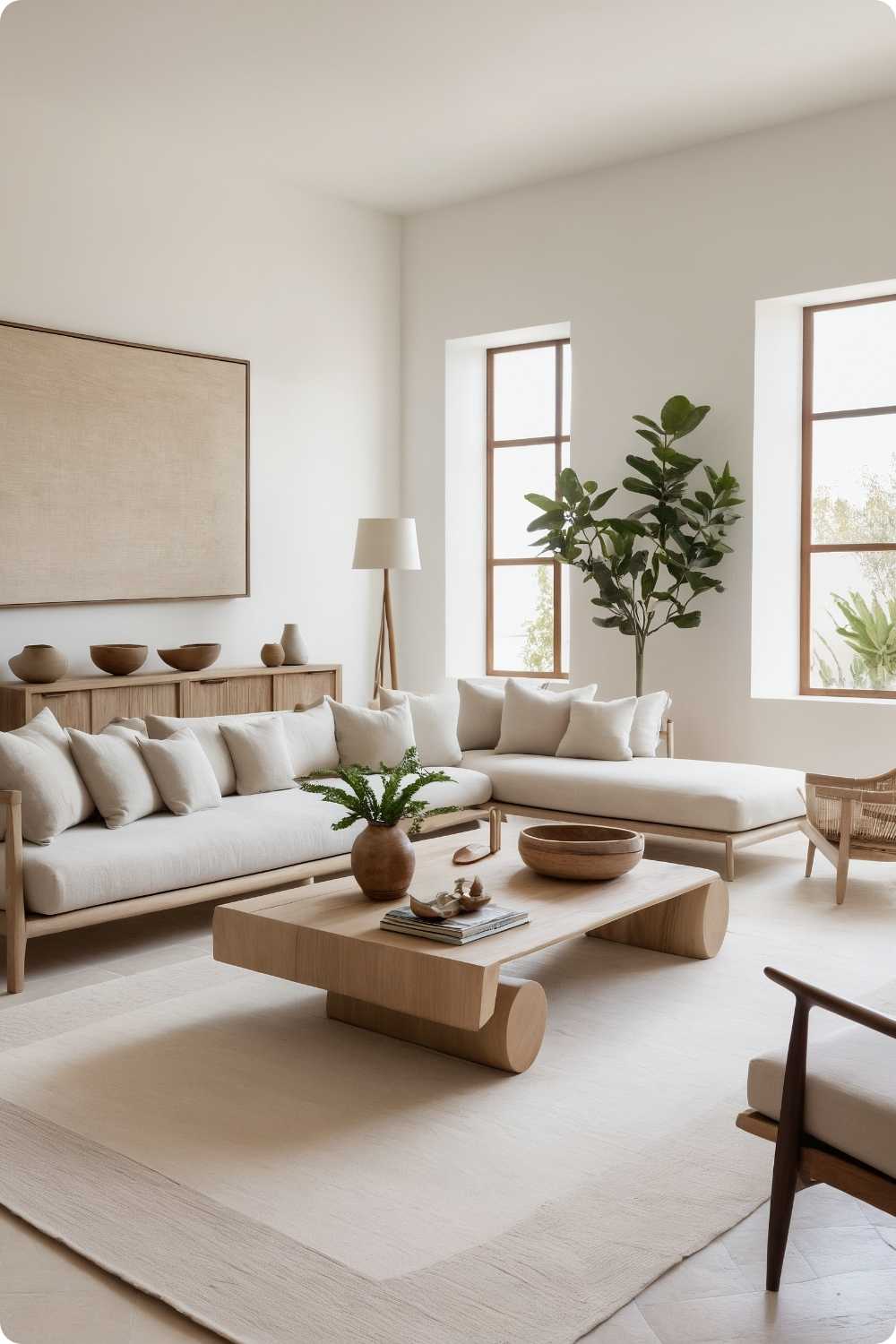
Traditional Spanish Colonial homes included religious art, family portraits, and regional craft pieces that reflected cultural values and personal history. Modern interpretations need to maintain this emphasis on meaningful rather than arbitrary decoration.
Minimalist art pieces can work in contemporary hacienda homes when they complement rather than compete with architectural elements and natural materials. The goal is enhancing spatial character while maintaining visual calm.
Neutral tones and abstract shapes provide contemporary sophistication while avoiding the cultural appropriation issues that can arise from using religious or culturally specific imagery without proper understanding and respect.
The placement and lighting of art requires understanding viewing angles, natural light patterns, and relationships with furniture and architectural elements to create cohesive rather than competing visual experiences.
My Professional Insights and Recommendations
Through years of designing modern hacienda interiors, I’ve learned that authenticity requires understanding cultural heritage and traditional building practices, not just copying surface appearances. The most successful projects honor Spanish Colonial traditions while meeting contemporary functional needs and lifestyle requirements.
Start by studying authentic hacienda architecture to understand how traditional forms developed from practical needs and local materials. Visit historic sites, museums, or authentic restorations to experience how these spaces actually worked before attempting modern interpretations.
Invest in quality materials and skilled craftspeople rather than trying to achieve authentic appearances through shortcuts or mass-produced alternatives. Traditional techniques and natural materials develop character over time while artificial substitutes often deteriorate or appear obviously fake as they age.
Remember that hacienda design principles—emphasis on family gathering, indoor-outdoor living, connection to place, and integration of functional and beautiful elements—remain as relevant today as they were centuries ago. The most successful modern hacienda homes support these values while incorporating contemporary comfort and technology.

